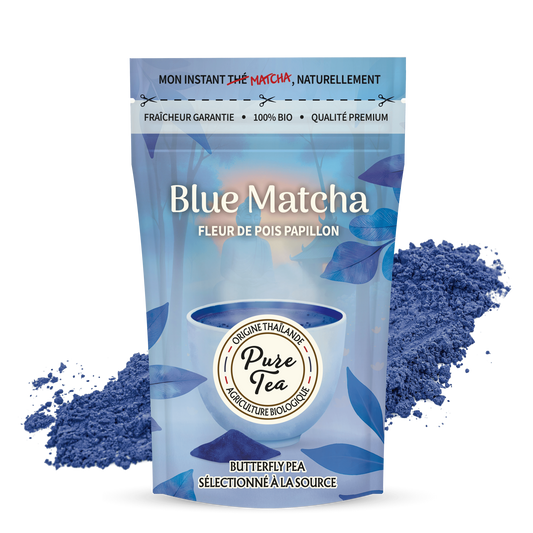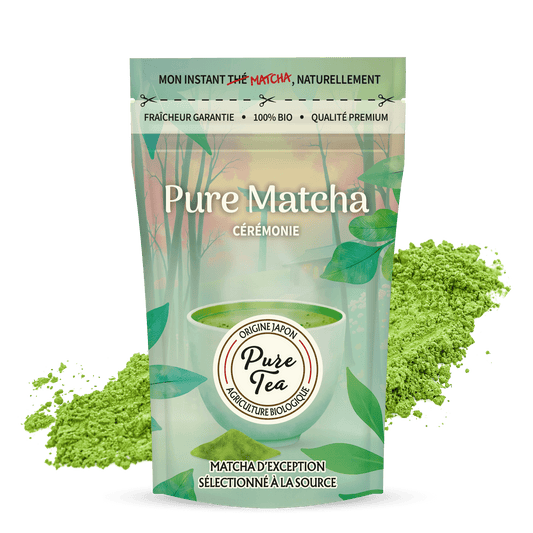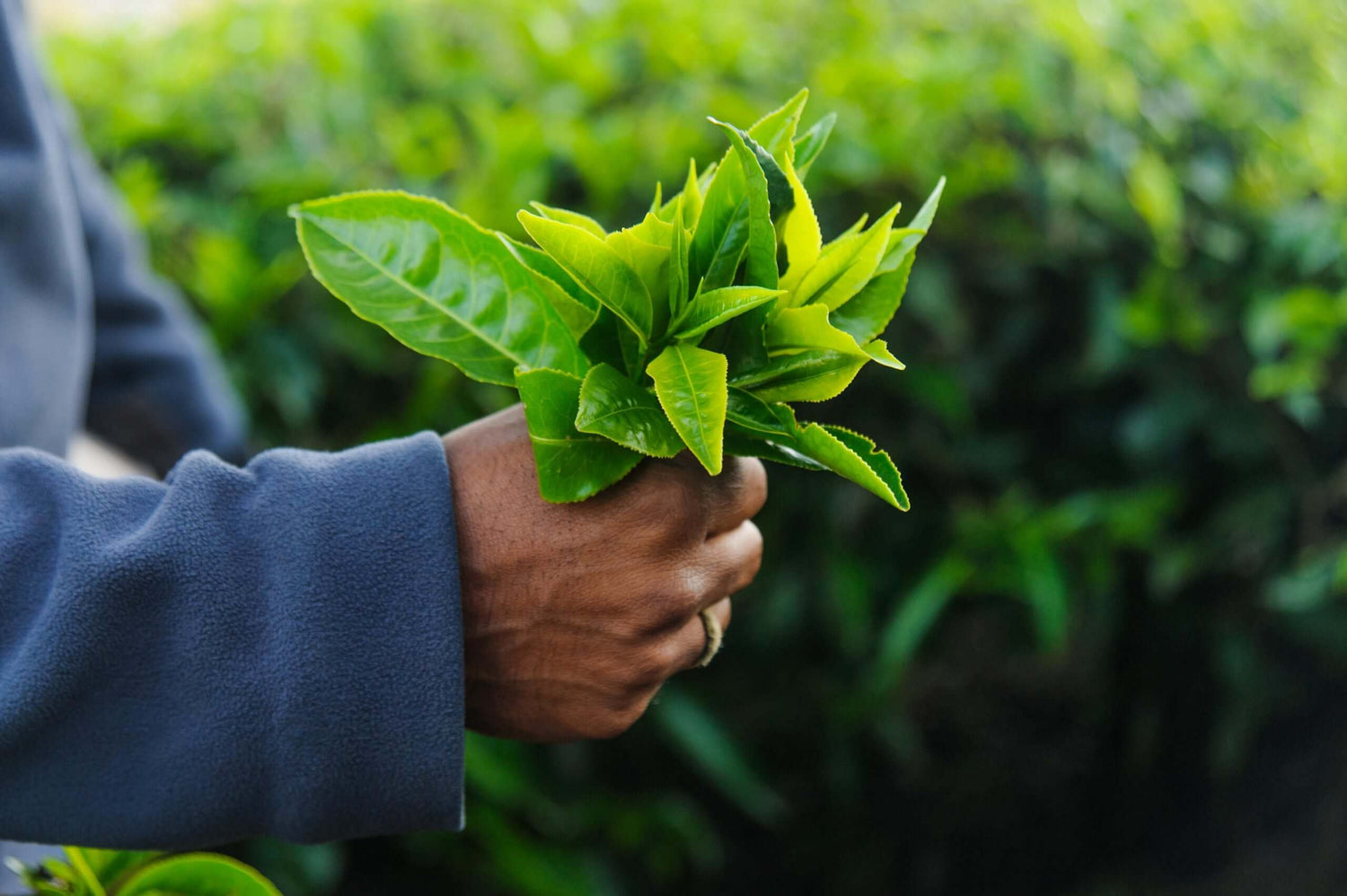Drinking green tea is a universal ritual, repeated billions of times each day around the world. But behind this simple habit lies an ancient, complex, and fascinating story, where botany, social rituals, pharmacopoeia, and lifestyle have been intertwined for more than three thousand years. And while there are countless green teas, two types hold a special place in Chinese culture: Chun Mee, with its fruity, vibrant profile, and Sencha, smooth and vegetal. These are the two teas, both grown according to organic farming principles, that make up Pure Tea’s signature blends.
In this article, we invite you to take an in-depth look at the origins of green tea, to understand the agronomic and sensory specifics of Chun Mee and Sencha, and to review recent scientific studies that shed light on their effects on the human body.
The origin of green tea: one plant, many traditions
The tea plant, Camellia sinensis, is native to southern China and northern India. According to historians, its use as an infusion dates back to the Shang dynasty (between 1600 and 1046 BCE). Initially used as a medicinal plant, tea gradually became a daily beverage among the imperial elite, in monasteries, and eventually throughout all levels of Chinese society.
What sets green tea apart from other types (black, oolong, white) is that it undergoes no oxidation. Immediately after picking, the leaves are heated (by steam or in a metal wok) to deactivate the enzymes responsible for oxidation. This step, called fixation, preserves the catechins, amino acids, chlorophylls, and other volatile compounds that give green tea its flavor and health benefits.
As early as the Tang and Song dynasties, writings such as Lu Yu’s Classic of Tea (8th century) gave detailed descriptions of green tea cultivation, preparation, and virtues. This cultural heritage has endured through the centuries, adapting to changes in agricultural practices while maintaining deep continuity.
Chun Mee green tea: balance of freshness, energy, and delicacy
Among the many varieties produced in China, Chun Mee is one of the most iconic green teas. Originating from the Jiangxi and Zhejiang provinces, it is recognizable by its curved leaves, which resemble a delicate eyebrow—hence its name, Chun Mee ("old man's eyebrow" in Chinese).
Artisanal production that respects the leaf
Chun Mee leaves are generally harvested in spring, sometimes in summer depending on the region. Once picked, they are wilted, then heated in large metal woks at high temperatures—a process requiring precision and skill. Hand-rolling gives the leaves their distinctive shape. A final roasting step fine-tunes the flavor, which remains smooth but with a slight acidity on the finish.
In the organic versions, like those chosen for Pure Tea blends, this process remains manual or semi-artisanal, with no additives or added flavors, to preserve the tea’s natural chemistry as much as possible.
A distinctive sensory profile
When steeped, Chun Mee develops a pale yellow to golden color, sometimes slightly cloudy. On the palate, it stands out for its fresh, vegetal taste, complemented by fruity, almost tangy notes that sometimes evolve into flavors of green plum or citrus zest.
It’s often recommended for those who want a lively but gentle tea, with a moderate caffeine content, making it a great alternative to morning coffee or a daytime companion drink. This is the same organic Chun Mee green tea you’ll find in our energizing blend, Green Tea Energy Organic.
Sencha green tea: smoothness, balance, and everyday use
While the name Sencha often brings to mind Japanese teas, there is also a Chinese Sencha tradition, which is less well-known but just as refined. In this context, "Sencha" refers to a production method similar to the Japanese technique, but adapted to Chinese terroirs, particularly in the Hunan and Anhui regions.
Manufacturing method
Chinese Sencha is usually steamed quickly after harvest, then rolled and dried. This method, different from the wok-rolling used for other Chinese green teas, helps preserve a chemical profile close to the fresh leaf, with a high level of L-theanine, an amino acid responsible for the relaxing effect often associated with green tea.
The result is a tea with a smoother, rounder taste and a very light astringency, if any. Unlike some Japanese Sencha, this one has a less briny and more floral profile.
An ideal base for wellness blends
Thanks to its smoothness and low bitterness, Chinese Sencha is often used as a base for herbal infusions. It pairs very well with mint, citrus fruits, or even roots like ginger. That’s why you’ll find it in recipes like Organic Citrus and Ginger Sencha, Detox Beautea Queen, or Moroccan Mint Tea.
Nutritionally, it’s rich in catechins, polyphenols, and chlorophyll, and helps with gentle detoxification, while providing a mild, non-jittery boost.
What Science Says: The Benefits of Green Tea Explored in Depth
Numerous scientific studies have focused on the components of green tea. Here’s an overview of the main active compounds and their presumed health effects:
1. Catechins (EGCG)
Catechins are powerful antioxidants. The most studied, EGCG, has shown effects in:
-
the neutralization of free radicals
-
prevention of cellular aging
-
regulation of fat metabolism
2. L-theanine
Found especially in quality green teas, it is known for:
-
promote a state of mental relaxation without drowsiness
-
enhance focus when combined with caffeine
-
help maintain a stable mental balance, especially useful to counteract the effects of stress
3. Chlorophyll
The chlorophyll in unoxidized leaves is believed to have the following effects:
-
gentle detoxifiers
-
liver protectors
-
potentially beneficial for digestion
It should be noted that these effects are linked to regular, moderate, and high-quality consumption—such as that provided by untreated organic green teas.
How to brew these green teas for the best results
Chun Mee
-
Ideal temperature: 75–80°C
-
Steeping time: 2 to 3 minutes
-
Tip: avoid over-steeping, which increases bitterness
Chinese Sencha
-
Ideal temperature: 158–167°F
-
Steeping time: 1.5 to 2.5 minutes
-
Tip: can be cold brewed (slow infusion in cold water for 4 hours)
Chun Mee and Chinese Sencha represent two complementary approaches to green tea. The first, lively and fruity, is perfect for an active start to the day. The second, rounder and more vegetal, fits easily into moments of calm or digestion. Both continue a living tradition—a tea rooted in nature, shaped by human hands, and able to endure through the centuries without losing its appeal.
With their diverse flavors, subtle botanical differences, and nutritional properties, they invite you to explore green tea not as a single product, but as a world of nuances, traditions, and know-how. Learning to prepare and taste them is also an opportunity to slow down—and reconnect with a simple yet meaningful ritual.

















